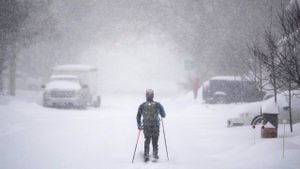South Korea is bracing for significant snowfall and potential flooding as heavy rain and snow are expected across various regions, particularly affecting the capital city, Seoul, and its surrounding areas. The Korea Meteorological Administration has issued alerts for heavy snowfall, predicting accumulations of up to 10 cm starting from the early hours of December 12.
According to reports, the weather forecast indicates freezing temperatures with lows dipping to -6 degrees Celsius, but daytime temperatures are predicted to rise to between 3 and 13 degrees. A variegated weather pattern suggests light rains could transform to snow, significantly impacting local travel and commute during the morning rush hour.
On December 10, front-page reports showcased the extreme morning temperatures across South Korea, which were markedly low compared to seasonal averages, particularly around -10 degrees. By midday, citizens were enjoying mildly warmer weather, with temperatures recovering to about 6 degrees. Many people took the opportunity to engage in outdoor activities at parks, shedding thick jackets as they walked along the Han River, enjoying the brief respite from the cold.
Weather forecasts have outlined expectations of varying intensities of snow and rain throughout the day. From early morning until noon, parts of metropolitan areas like Seoul, Gyeonggi, and certain regions of Gangwon could see heavy snow, with potential hourly rates of 1 to 3 cm. Meanwhile, rain is anticipated as temperatures gradually increase, transforming snow to rain, especially as the day progresses.
Officials warn of commonly reported road hazards associated with the weather pattern, particularly black ice on roads and poor visibility due to blustery conditions. Such factors necessitate caution among commuters and travelers alike.
From December 12 onwards, the forecast suggests continued precipitation with warnings of blustery conditions. Particularly, mountainous regions of Gangwon and higher elevations could experience significant snowfall, with forecasters predicting accumulations reflective of the current weather model. This is due to the cold, moist air patterns settling over the peninsula.
Currently, the air quality index across several regions, including the capital area, shows high levels of fine dust pollution, indicating potential health risks. Monitoring agencies have advised residents to limit outdoor activities and protect themselves amid poor air quality conditions, particularly during colder times when air tends to stagnate.
The cold snap and snow transition are leading many citizens to prepare adequately, avoiding unnecessary travel and ensuring safety on their routes. The government has emphasized the importance of heeding weather advisories particularly when driving during anticipated snowfalls.
Officials have also reiterated the risks of flooding associated with the rainfall expected to follow the snow as temperatures rise, leading to rapid snowmelt. This raises concerns about the water channels and drainage systems being overwhelmed, especially within urban setups. Those living adjacent to water bodies are advised to monitor advance warnings.
Experts recommend regular updates from appropriate meteorological services to remain informed on weather changes, driving conditions, and any safety protocols advised by local authorities.
Long-term forecasts indicate relief from the cold will come with warmer temperatures leading possibly to more rainfall rather than snow. This fluctuation creates conditions for potential flooding, especially if substantial melting occurs.
Through the winter weeks, meteorologists continue to surveil changes closely, predicting varied weather patterns which may pose challenges for everyday life, necessitating community vigilance and readiness.
While some view heavy snowfall and rain as merely part of the winter seasonal shuffle, the harsh conditions put forward dilemmas not only for commuters but for emergency services as well. From managing ice-affected roadways to ensuring safety protocols at the local level, the impact of the winter weather is palpable.
Citizens are encouraged to remain cognizant of their surroundings, keep emergency provisions prepared, and heed warnings from officials which aim to mitigate the risks associated with extreme weather conditions. Reports on power flurries forecast for city centers and the south must be taken seriously as South Korea manages the balance of winter weather's beauty and its accompanying hazards.



